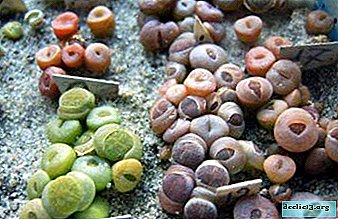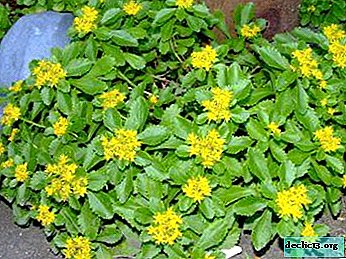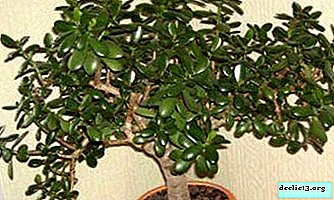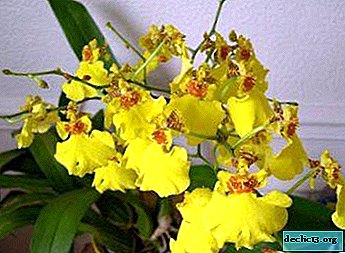Why can yellow and brown spots appear on the leaves of lemon and how to get rid of them?
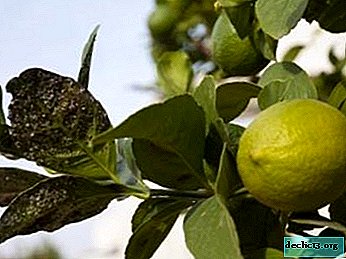
On a healthy lemon tree, only fruits can be yellow. If yellow spots appear on the leaves, the lemon is in danger and may die.
Foliage signals problems, being an excellent natural indicator of the state of the plant.
An attentive hostess will only have to determine the source of the trouble and take the necessary measures. This article describes the main preventive measures against various diseases and pests of lemon. Let's consider everything in order.
Signs of the phenomenon
The leaves of a healthy lemon are clean, supple, smooth, and are saturated green. Unhealthy spotting manifests itself in different ways, depending on the cause that caused it. The following changes should be alert:
- Leaf plates are covered with spots that do not have clear boundaries - stains. Some have a pronounced yellow color, others are barely noticeable.
- Almost all foliage suddenly and quickly turns yellow, loses elasticity and smoothness.
- An edge burn is observed - the edge turns yellow and dries, the leaves fall off.
- The spots are similar to small specks that merge over time. A completely yellowed leaf falls off.
- Rounded spots with clear contours appear on the part of the deciduous apparatus. The number of spots increases or decreases noticeably. Symptoms are observed for a long time, the plant gradually withers.
- Round spots appear not only on the leaves, but also on all parts of the tree.
Causes of spotting and ways to get rid of the problem
A correctly diagnosed and timely measures taken will quickly get rid of the problem, preserving the plant.
Pests
Surprisingly, various pests often appear on indoor lemons. Pests can enter the premises:
- with contaminated soil;
- with a bouquet of flowers or new indoor plants;
- from the street - through a window or outerwear.
 The most common pests include:
The most common pests include:
- Scaffolds and false shields:
- feed on the juice of various parts of the plant, damaging the stems, leaf plates and lemon fruits;
- produce a sticky substance that disrupts the processes of respiration and photosynthesis of the plant and is a nutrient medium for fungi;
- reduce the protective properties of wood.
- Mites - Spider Web, Citrus and Mite Mite:
- leaf-sucking insects that prefer young leaves;
- form a kind of web in the depths of folded leaves, disrupting photosynthesis;
- spread viral diseases of plants.
Identify plants affected by insects by the following features:
- characteristic yellowish or reddish-brown dots appear at the puncture sites of the sheet surface;
- the tips of the leaves turn yellow, the plate folds;
- leaves change color to yellow, then brown;
- foliage dries and dies;
- flowers and ovaries dry up and fall;
- a web appears (in the late stage of tick infection);
- the tree stops growing, it is "starving";
- the plant dies.
Ways to fight
It is not easy to get rid of harmful insects:
- pests multiply very quickly, spreading through the infected tree and neighboring plants;
- scale shields are covered with shields that reduce the effects of poison;
- ticks survive adverse periods, hibernating and hiding in the smallest crevices and soil.
 By combining various methods of control, you can increase the likelihood of complete destruction of pests:
By combining various methods of control, you can increase the likelihood of complete destruction of pests:
- Mechanical. Having put a plastic bag on the container with the plant, wash the leaves with a solution of laundry soap and warm water or wipe with a cloth moistened with this mixture. After an hour, rinse the leaves under the shower. Repeat the procedure after 2-3 days.
- Chemical. A wide range of pesticides will allow you to choose the most effective in pest control. Processing is performed several times with an interval of 7-10 days. The use of this scheme will first destroy adults, and then the larvae hatching from eggs.
It is important to periodically change drugs, since insects can develop immunity to persistent irritants.
Diseases and their treatment
Indoor lemons are often affected by infectious, viral and fungal diseases.due to:
- the exactingness of all citrus fruits to growing conditions;
- improper care of plants.
The most common diseases of lemons:
- Late blight - a fungal disease that affects all parts of the plant. On the leaves, it appears oily yellowish spots, turning brown with time. Weak plants are most susceptible to weakened plants.
The development of the disease contributes to air humidity above 90% at a temperature of 18-20 degrees. Treatment should be started as early as possible, otherwise it will be difficult to save the tree. The following methods are used to save citrus:
- thorough inspection of the plant (including the root system) and removal of all affected parts with the capture of healthy wood up to 10-12 cm;
- processing slices with a ten percent solution of copper sulfate;
- spraying the whole tree with fungicides containing copper (copper sulfate can be diluted in the proportion of 1 tsp to 2 l of water).
- Root rot - an infectious disease affecting the root system of a lemon. It is characterized by massive yellowing and dropping of foliage.
The appearance and development of infection is associated with regular waterlogging of the soil or wounding of the roots during transplantation. The treatment is as follows:
- removal of rotten roots to clean cuts;
- processing of slices with crushed activated carbon or sulfur powder;
- complete replacement of soil in the tank;
- watering no earlier than 7 days after transplantation (to avoid relapse);
- leaf treatment with wet wipes;
- diffused lighting for at least 12 hours a day (illuminate if necessary).
Micronutrient deficiency
 The condition of the tree and its deciduous apparatus directly depends on the amount of necessary nutrients. Spots on the leaves may indicate a lack of the following chemical elements:
The condition of the tree and its deciduous apparatus directly depends on the amount of necessary nutrients. Spots on the leaves may indicate a lack of the following chemical elements:
- Iron. The yellow spots fade over time, the leaves dry out and fall off.
- Potassium. Spots of yellow-bronze color against the background of a darkened sheet plate covered with folds.
- Manganese. The upper leaves of citrus dazzle: gray-yellow stains appear between the green veins.
- Zinc. Spots of bronze and gray-brown color are randomly located on abnormally small leaves. A yellow spot appears on young leaves.
In the warm season, top dressing is applied 1 time in 7-10 days, in the cold - 1 time per month. It is important to use fertilizers strictly according to the instructions, because an overabundance of chemical elements also has a negative effect on plants.
Improper care of a home plant
All citrus plants are quite demanding of the environment and living conditions. If the room is not provided with an appropriate microclimate, the lemon tree will start to hurt and stop developing.
- Excessive watering leads to stagnation of water in the pot, a change in the composition of the soil, its oxidation, and the appearance of mold. As a result, the root system is not able to fully function and supply the plant with nutrients. In the worst case, infections of the soil, roots and the whole tree develop.
To help a plant affected by excess moisture, you can:
- completely replacing the soil;
- providing optimal watering, avoiding waterlogging and drying out of the earth coma.
- Drafts, insufficient temperature, its jumps for tropical lemons are serious risk factors. In such conditions, the plant weakens, becoming an easy victim of pests, viral, infectious and fungal diseases. Health indoor lemons will return compliance with the temperature regime.
What to do if brown spots?
 The appearance on the leaves of spots of saturated dark brown color and irregular shape may indicate such a serious disease as cancer of citrus. It is caused by bacteria that infect foliage, fruits, and sometimes wood of trees.
The appearance on the leaves of spots of saturated dark brown color and irregular shape may indicate such a serious disease as cancer of citrus. It is caused by bacteria that infect foliage, fruits, and sometimes wood of trees.
Unfortunately, a plant affected by this ailment cannot be cured. It must be burned to prevent the spread of the disease to other plants. The soil from the pot is disposed of.
The only way to fight citrus cancer is preventionconsisting in monthly spraying of healthy plants with a light pink solution of potassium permanganate.
Prevention
The best prevention to prevent diseases and stains is to create optimal conditions for the growth and development of lemon tree:
- Lighting. Located in the brightest place of the apartment, avoiding direct sunlight. In case of lack of light, use special lamps. Daylight hours for lemons - 12 hours.
- Temperature mode. Comfortable temperature in summer is 18-22 degrees Celsius, in winter and spring - 16-18 degrees. In summer, you can keep on the closed balcony. Avoid drafts.
- Humidity. General recommendations: summer watering - about 3 times a week, winter - 1 time per week. The number of irrigations can vary, depending on the air temperature. The main thing is that the soil should always be slightly moist. At any time of the year, daily spraying is recommended, preferably not around the tree itself, but around it.
- Top dressing. Produce special complex fertilizers for citrus crops. Observe the terms and standards according to the instructions. In special cases (plant diseases), additional feeding is possible.
- Transfer. Until the age of 3, lemons are transplanted every year. Then the transplant is reduced to 1 time in 2-3 years. The procedure is carried out in spring or autumn.
- Pruning. It is done in order to form a crown, stimulate fruiting, sanitize, thin out thickened areas. It is made with sharp scissors or secateurs.
- Features. Lemon does not like changing places and conditions, it is long and difficult to adapt to a new environment.
Indoor lemon is rarely seen in a city apartment. After all, its cultivation and maintenance is a troublesome and laborious task. But the thing is worth it: a well-groomed tropical handsome man is a real decoration of the house and a compliment to the caring hands of the hostess.



